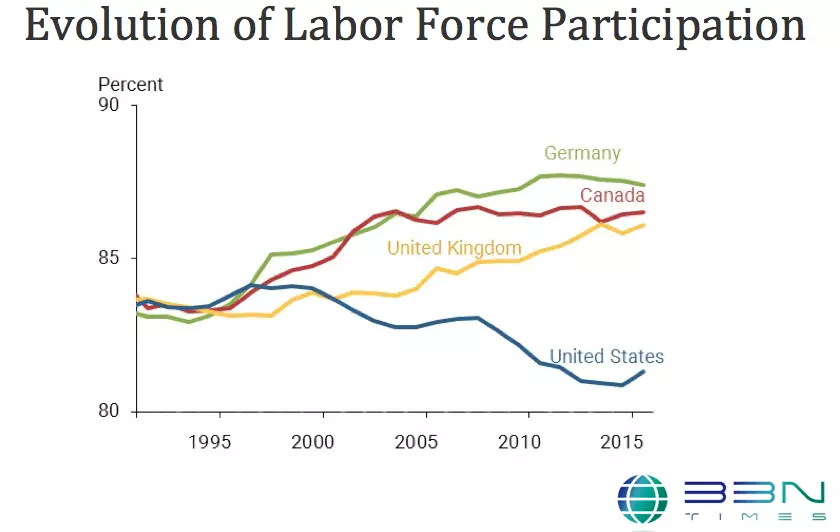Not all that long ago in 1990, the share of :"prime-age" workers from 25-54 who were participating in the labor force was basically the same in the United States, Germany, Canada, and Japan. But since then, labor force participation in this group has fallen in the United States while rising in the other countries. Mary C. Daly lays out the pattern in "Raising the Speed Limit on Future Growth" (Federal Reserve Bank of San Franciso Economic Letter, April 2, 2018).
Here's a figure showing the evolution of labor force participation in the 25-54 age bracket in these four economies. Economists often like to focus on this group because it avoids differences in rates of college attendance (which can strongly influence labor force participation at younger years) and differences in old-age pension systems and retirement patterns (which can strongly influence labor force participation in older years).

Daly writes (citations omitted):
"Which raises the question—why aren’t American workers working?
"The answer is not simple, and numerous factors have been offered to explain the decline in labor force participation. Research by a colleague from the San Francisco Fed and others suggests that some of the drop owes to wealthier families choosing to have only one person engaging in the paid labor market ...
"Another factor behind the decline is ongoing job polarization that favors workers at the high and low ends of the skill distribution but not those in the middle. ... Our economy is automating thousands of jobs in the middle-skill range, from call center workers, to paralegals, to grocery checkers.A growing body of research finds that these pressures on middle-skilled jobs leave a big swath of workers on the sidelines, wanting work but not having the skills to keep pace with the ever-changing economy.
"The final and perhaps most critical issue I want to highlight also relates to skills: We’re not adequately preparing a large fraction of our young people for the jobs of the future. Like in most advanced economies, job creation in the United States is being tilted toward jobs that require a college degree . Even if high school-educated workers can find jobs today, their future job security is in jeopardy. Indeed by 2020, for the first time in our history, more jobs will require a bachelor’s degree than a high school diploma.
"These statistics contrast with the trends for college completion. Although the share of young people with four-year college degrees is rising, in 2016 only 37% of 25- to 29-year-olds had a college diploma. This falls short of the progress in many of our international competitors, but also means that many of our young people are underprepared for the jobs in our economy."
On this last point, my own emphasis would differ from Daly's. Yes, steps that aim to increase college attendance over time are often worthwhile. But as she notes, only 37% of American 25-29 year-olds have a college degree. A dramatic rise in this number would take an extraordinary social effort. Among other things, it would require a dramatic expansion in the number of those leaving high school who are willing and ready to benefit from a college degree, together with a vast enrollments across the higher education sector. Even if the share of college graduates could be increased by one-third or one-half--which would be a very dramatic change--a very large share of the population would not have a college degree.
It seems to me important to separate the ideas of "college" and "additional job-related training." It's true that the secure and decently-paid jobs of the future will typically require additional training past high school. At least in theory, that training could be provided in many ways: on-the-job training, apprenticeships, focused short courses focused certifying competence in a certain area, and so on. For some students, a conventional college degree will be a way to build up these skills. However, there are also a substantial number of students who are unlikely to flourish in a conventional classroom-based college environment, and a substantial number of jobs where a traditional college classroom doesn't offer the right preparation. College isn't the right job prep for everyone. We need to build up other avenues for US workers to acquire the job-related skills they need, too.




Leave your comments
Post comment as a guest